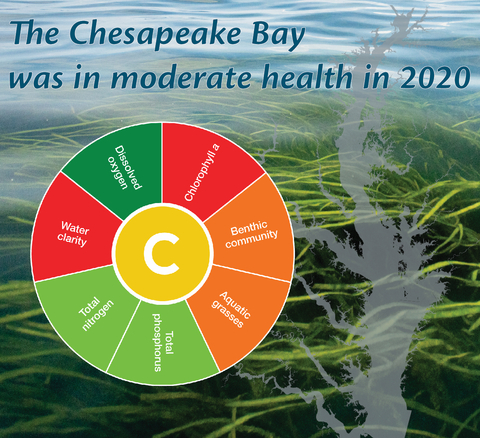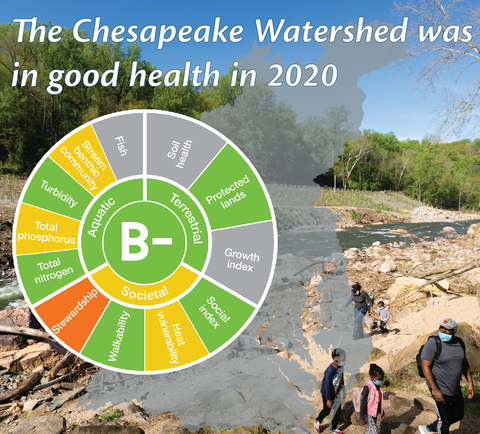Words like “moderate” and even “good” are being used to describe the health of the Chesapeake Bay and its watershed in the University of Maryland Center for Environmental Science’s (UMCES) 2020 report card, released Tuesday.
UMCES gave the watershed a grade of B- for 2020, while the Bay itself improved from a C- to a C. While some individual factors had mixed results, the Baywide trend was overall positive, the center says.

Among the success stories: dissolved oxygen and total nitrogren levels. Chlorophyll and total phosphorus scores, on the other hand, were worse in 2020. Water clarity, benthic community, and aquatic grass were also slightly worse than the previous year.
UMCES notes that among the regions reported, the Elizabeth River held steady. The highest-ranked region was the Lower Bay, while the Patapsco and Back Rivers region was the lowest ranked.
The watershed (versus the Chesapeake Bay itself) is generally considered in good health. Total nitrogen was the highest scoring factor. The West Branch Susquehanna had the best marks, with a rare A- grade. The York was the lowest scoring region, with a C.
The Watershed Report Card has expanded to include new health indicators like protected lands, stewardship (volunteerism and civic action), walkability, and heat vulnerability. The watershed health analysis uses 23 reporting regions and factors both ecological and social indicators into its scores. Throughout the report, there a notable emphasis on environmental justice.
“Improvements in our environment go hand-in-hand with improvements in our communities particularly those that are traditionally disadvantaged,” said UMCES President Dr. Peter Goodwin.
UMCES says it will expand the indicators that measure environmental justice, especially those that address economic disparities. Right now, graduate students within the University System of Maryland are developing an environmental justice index.

One of the new indicators included in 2020, walkability, factors in how many people can walk to a park in 10 minutes. It was a more important indicator than ever before during the pandemic, when parks were among the few options for people to get exercise, fresh air, and a change of scenery.
“During the nation’s worst public health crisis in 100 years, people sought out and found comfort and joy in green spaces, like parks, beaches, historic landmarks, and local ball fields,” said Wendy O’Sullivan, Superintendent of the National Park Service’s Chesapeake Bay Office. “There is no doubt that our parks and recreational spaces are more important than ever. Conserving and protecting lands and ensuring equitable public access are key priorities for the overall health of the Chesapeake watershed and its communities.”
Support from the National Fish and Wildlife Foundation allowed UMCES to expand the assessment to include social and economic indicators across the watershed.
It should be noted that due to the pandemic, there was a gap in monitoring from March to May 2020, while most of the Bay states were under a stay-at-home order. On the other hand, the center notes a reduction in atmospheric nitrogen on the region thanks to reduced travel in 2020.
“Although we have lots of work ahead of us, I am confident that our shared commitments will help ensure that the Chesapeake Bay remains one of America’s great environmental treasures for generations to come,” said Congressman John Sarbanes, Co-Chair of the Chesapeake Bay Watershed Task Force.
To see an interactive version of the report, click here.
–Meg Walburn Viviano




